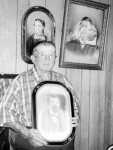Sharing history

New Madrid family's past is sewn to unique handmade machine
NEW MADRID - The Kimball family's history threads its way through New Madrid's past for generations. Part of that past is sewn up in a very special well-worn, hand-crafted machine.
Family history, passed from generation to generation, explains this is the first mechanical sewing machine ever built. The Kimballs say it was the source for the idea used by inventor Elias Howe to create his sewing machine.
Today, the Kimball family is sharing their history and the machine created by James Kimball in the early 1800s with the public. Once kept tucked away in a trunk, covered by quilts and taken out only on rare occasions, the machine is now on loan to the New Madrid Historical Museum.
"Everyone finds the machine and its history remarkable," said Virginia Carlson, museum director. "There has been a lot of interest in it."

The machine was presented by John Kimball of Phoenix, Ariz. A native of New Madrid, Kimball inherited the machine from his great-aunt, Annie Kimball LaMastus, and the story of its past from his parents, Lillian and Barney Kimball.
The 91-year-old father is proud of his son's donation and equally proud of the story behind it.
Family history, which was verified by a local historian in the early 1940s, credits James Kimball with creating the very first mechanical sewing machine.
Well-known in the 1800s for his ability to build and repair machines, Kimball worked with machinery operating grist-mills, cotton gins and saw mills and served as a local gunsmith.
"They told me my great-granddaddy could make any machine," said Kimball. "When Howe heard he had a working sewing machine, he came down here and got all buddy-buddy with my great-granddaddy and got his idea."
Kimball reportedly created three of the machines. In addition to the one which remained in the family, one reportedly went west during the gold rush of 1849. No one knows what happened to the third machine.
When word reached New Madrid of Howe's patent, which was secured on Sept. 18, 1846, townspeople interviewed in the 1940s remembered indignation arose among New Madrid's citizens.
In a 1967 article published in the New Madrid Weekly Record about the sewing machine's history it stated trips were made to Washington by Kimball and others to protest the patent. Eventually Kimball refused to sue and requested they drop the effort.
"It is perhaps well that Howe applied the principals he observed and patented it for the world to use, for Kimball had no thought of gain or money but only of making things; and it might have been many years longer before the machine would have been given to the world," noted the article.
While the world didn't beat a path to their door, Kimball recalls sewing company officials coming to inspect the machine. "They wanted it but they didn't want to give nothing for it," he said.
So it stayed in the family.
"Aunt Annie had it in her possession for years. The only time anyone got to see it was by appointment," recalled Kimball. "I probably saw it only a few times, the earliest I can remember seeing it was when I was in my 20s."
Mrs. Kimball watched others sew with the ancient machine that uses a straight needle above and a curved needle below, feeding the thread through spools. A treadle operates the machinery.
"They say Howe stole the idea for the bobbins. He was trying to invent a sewing machine and couldn't get it, so he just copied (James Kimball's) idea," she said.
The Kimballs admit they sometimes think about how the family's life might have been different had James Kimball patented the first mechanical sewing machine. "Why there sure would be different people who got money out of it," said Kimball with a grin. "But I don't know if it really would have made a difference or not."
But they have their family history and you can't put a price on that.

